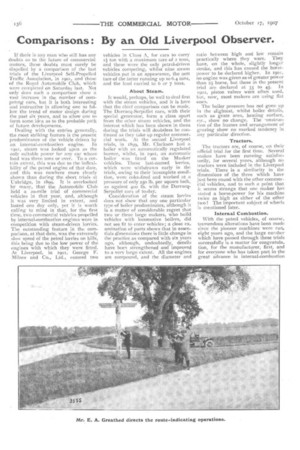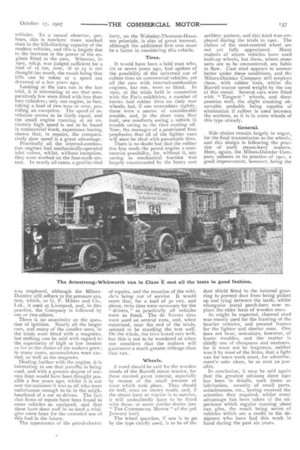Comparisons : By an Old Liverpool Observer1
Page 18

Page 19

If you've noticed an error in this article please click here to report it so we can fix it.
If thee is any man who still has any doubts as to the future of commercial motors, these doubts must surely be dispelled by a comparison of the last trials of the Liverpool Self-Propelled Traffic Association, in 1901, and those of the Royal Automobile Club, which were completed on Saturday last. Not only does such a comparison show a vast increase in the number of competing cars, but it is both interesting and instructive in allowing one to follow the trend of motor design during the past six years, and to allow one to form some idea as to the probable path of future developments.
Dealing with the entries generally, the most striking feature is the present predominance of the vehicle driven by an internal-combustion engine. in i9or, steam was looked upon as the only suitable power for any car whose load was three tons or over. To a certain extent, this was due to the inflexibility of the petrol engine of that date, and this was nowhere more clearly shown than during the short trials at Uxbridge, in 1899. It is overlooked by many, that the Automobile Club held a 20-mile trial of commercial vehicles in that year, and, although it was very limited in extent, and lasted one day only, yet it is worth calling to mind in that, for the first time, two cornmercial vehicles propelled by internal-combustion engines were in competition with steam-driven lorries. The outstanding feature in the comparison, at that date, was the extremely slow speed of the petrol lorries on hills, this being due to the low power of the engines with which they were fitted. At Liverpool, in r9o1, George F. Milnes and Co., Ltd., entered two
vehicles in Class A, for cars to carry
ton with a maximum tare of 2 tons, and these were the only petrol-driven vehicles competing, whilst nine steam vehicles put in an appearance, the nett tare of the tatter running up to 6.4 tons, and the load carried to 6 or 7 tons.
About Steam.
It would, perhaps, be well to deal first with the steam vehicles, and it is here that the chief comparison can be made. The Darracq-Serpollet cars, with their special generator, form a class apart from the other steam vehicles, and the interest which has been shown in them during the trials will doubtless be continued as they take up regular wannercial work. At the second Liverpool trials, in 1899, Mr. Clarkson had a boiler with an automatically regulated burner, whilst, in 1901, an automatic boiler was lilted on the Musker vehicles. These last-named lorries, which were withdrawn early in the trials, owing to their incomplete condition, were coke-fired and worked at a pressure of only 250 lb. per square inch, as against 400 lb. with the DarracqSerpollet cars of to-day.
Consideration of the steam lorries does not show thal any one particular type of boiler predominates, although it is a matter of considerable regret that two or three large makers, who build vehicles with locomotive boilers, did not see fit to enter vehicles ; a close ex_ amination of parts 'shows that in essentials dimensions there is little change in the practice as compared with six years ago, although, undoubtedly, details have been strengthened and improved to a very large extent. All the engines are compound, and the diameter and ratio between high and low remain practically where they were. They have, on the whole, slightly longer stroke, and this has caused the horsepower to be declared higher. In 1901, no engine was given as of greater power than 25 horse, but those in the present trial are declared at 35 to 45. In 1901, piston valves were often used, but, now, most makers are using flat h boiler pressure has not gone up oners_e in the slightest, whilst boiler details, such as grate area, heating surface, etc., show no change. The sonstruction of the frames and arrangement of gearing show no marked tendency in any particular direction.
Tractors.
The tractors are, of course, on their official trial for the first time. Several makes have been running satisfactorily, for several years, although no tractors were included in the Liverpool trials. There is a similarity in the dimensions of the three which have just been round with the other commercial vehicles, and to such a point that it seems strange that one maker has stated a horse-power for his machine twice as high as either of the other two! The important subject of wheels is mentioned later.
Internal Combustion.
With the petrol vehicles, of course, tremendous alterations have been made since the pioneer machineswere run,. eight years ago, and the large number which have passed through these trials successfully is a matter for congratulation, for the manufacturer, first, and for everyone who has taken part in the great advance in internal-combustion
vehicles. To a casual observer, perhaps, this is nowhere more marked than in the hill-climbing capacity of the modern vehicles, and this is largely due to the increase in the power of the engines fitted to the cars. Whereas, in 1901, toh.p. was judged sufficient for a load of if ton, now, a8 to 25 is not thought too much, the result being that hills can be taken at a speed not dreamed of a few years ago.
Looking at the cars run in the late trial, it is interesting to see that comparatively few were fitted with less than four cylinders; only one engine, in fact. taking a load of two tons or over, providing an exception. The speed of revolution 'seems to be fairly equal, and the small engine running at an extremely high speed is not to be found in commercial work, experience having shown that, in repairs, the comparatively slow speed is a great advantage.
Practically all the internal-combustion engines had mechanically-operated inlet valves, whilst, without exception, they were worked on the four-cycle system. In nearly all cases, a gravity-feed
was employed, although the MimesDaimler still still adhere to the pressure sys_ tern, which, as G. F. Milnes and Co., Ltd., it used at Liverpool, and, in this practice, the Company is followed by one or two others.
There is no unanimity on the question of ignition. Nearly all the larger cars, and many of the smaller ones, in the trials were fitted with a magneto, but nothing can be said with regard to the superiority of high or low tension as far as the choke of the makers goes; in many cases, accumulators were carried, as well as the magneto.
Dealing further with the engine, it is interesting to see that paraffin is being used, and with a greater degree of success than would have been thought possible a few years ago, whilst it is not now the nuisance it was to all who were unfortunate enough to be in the neighbourhood of a car so driven. The fact that firms of repute have been found to enter vehicles so equipped, and that these have done well in so hard a trial. give some hope for the extended use cf this fuel in the future.
The appearance of the petrol-electric lorry, on the Wolseley-Thomson-Houston principle, is also of great interest, although the additional first cost must be a factor in considering this vehicle.
Tires.
It would have been a bold man who, six or seven years ago, had spoken of the possibility of the universal use of rubber tires on commercial vehicles, yet all the cars with internal-combustion engines, bar one, were so fitted. In 1900, at the trials held in connection with the Paris exhibition, a number of lorries had rubber tires on their rear wheels, but, if one remembers rightly, these were a source of considerable trouble, and, in the short runs they took, one recollects seeing a vehicle in trouble owing to the tires coming off. Now, the manager of a prominent firm prophesies that all of the lighter vans will soon be shod with pneumatic tires. There is no doubt but that the rubber tire has made the petrol engine a commercial possibility, for, without it, any saving in mechanical traction was largely counteracted by the heavy cost
of repairs, and the vexation of the vehicle's being out of service. It would seem that, for a load of 30 cvvt. and above, twin tires were necessary for the " drivers," as practically all vehicles were so fitted. The de Ncvers tires were used on several vans, and, when examined, near the end of the trials, seemed to be standing the test well. On the whole, the tires lasted very well, but this is not to be wondered at when one considers that the makers will guarantee a much greater mileage than that run.
Wheels.
A word should be said for the wooden treads of the Burrell steam tractor, for these created great interest, especially by reason of the small amount of wear which took place. They should do well, even on snowy roads, and, if the steam lorry or tractor is to survive, it will undoubtedly have to be fitted with these, or some similar device (see " THE COMMERCIAL MOTOR "of the 3rd January last).
The wheel question, if one is to go by the type chiefly used, is to be of the artillery pattern, and this kind was employed during the trials in 1901. The claims of the steel-centred wheel are not yet fully appreciated. Many makers of steam vehicles have used built-up wheels, but these, where stone setts are to be encountered, are liable to flaw. Cast steel appears to answer better under these conditions, and the Milnes-Daimler Company still employs these, with rubber tires, whilst the Burrell tractor saved weight by the use of this metal. Several, cars were fitted with " Tangent " wheels, and these promise well, the slight creaking observable probably being capable of elimination if rubber is used between the sections, as it is in some wheels of this type already.
General.
Side chains remain largely in vogue, for the final transmission to the wheels, and this design is following the practice of 'early steam-lorry makers. Here, again, the Milnes-Daimler Company adheres to its practice of 1901, a good improvement, however, being the dust shield fitted to the internal gearring to prevent dust from being picked up and lying between the teeth, whilst triangular metal perch-bars now replace the older form of wooden ones. As might be expected, channel stee/ was mostly used for the framing of the heavier vehicles, and -pressed frames for the lighter and shorter ones. One does not hear, nowadays, however, of frame troubles, and the matter is chiefly one of cheapness and neatness, for it must not be forgotten, neither was it by most of the firms, that a light van for town work must, for advertise_ merit's sake alone, be as neat as possible.
In conclusion, it may be said again that the greatest advance since 1901 has been in details, such items as lubrication, security of small parts, noiselessness, etc., having received the attention they required, whilst every advantage has been taken of -the experience which regular running alone can give, the result being series of vehicles which are a credit to the designers who have had this work in hand during the past six years.






























